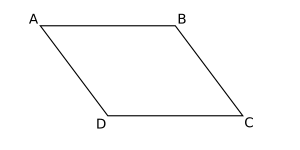Parallelogram facts for kids
A parallelogram is a special shape with four sides, also known as a quadrilateral. Imagine two pairs of parallel lines – lines that never meet, no matter how far they go. When these lines cross, they form a parallelogram!
In a parallelogram, the sides that are opposite each other are always the same length. For example, if one side is 5 cm long, the side across from it will also be 5 cm long. The word "parallelogram" comes from an old Greek word meaning "bounded by parallel lines."
Some shapes you might already know are actually parallelograms! These include Rectangles, rhombuses, and squares.
Look at the picture on the right. You can see that a parallelogram can be split into two triangles by drawing lines from corner to corner (these lines are called diagonals). The two triangles inside, named ABE and CDE, are exactly the same size and shape (they are congruent). This means:
- The line from A to E is the same length as the line from C to E.
- The line from B to E is the same length as the line from D to E.
Also, in any parallelogram, the angles that are opposite each other are always equal. For example, the angle at corner A is the same as the angle at corner C. Angles that are next to each other (like angle A and angle B) will always add up to 180 degrees.
Contents
What Makes a Parallelogram Special?
A simple four-sided shape is a parallelogram if it meets any one of these conditions:
- Its two pairs of opposite sides are equal in length.
- Its two pairs of opposite angles are equal in size.
- Its diagonals (the lines connecting opposite corners) cut each other exactly in half.
- One pair of opposite sides are parallel AND equal in length.
- The angles next to each other (called adjacent angles) add up to 180 degrees (they are supplementary).
- Each diagonal divides the shape into two congruent triangles (meaning they are identical in shape and size).
- It has rotational symmetry of order 2. This means if you spin it halfway around (180 degrees), it looks exactly the same.
Key Features of Parallelograms
Here are some important things to remember about parallelograms:
- Opposite sides of a parallelogram are always parallel to each other.
- If you draw any straight line through the very center of a parallelogram, it will divide the parallelogram's area into two equal parts.
- Parallelograms are a type of quadrilateral (a polygon with four sides).
Images for kids
See also
 In Spanish: Paralelogramo para niños
In Spanish: Paralelogramo para niños




